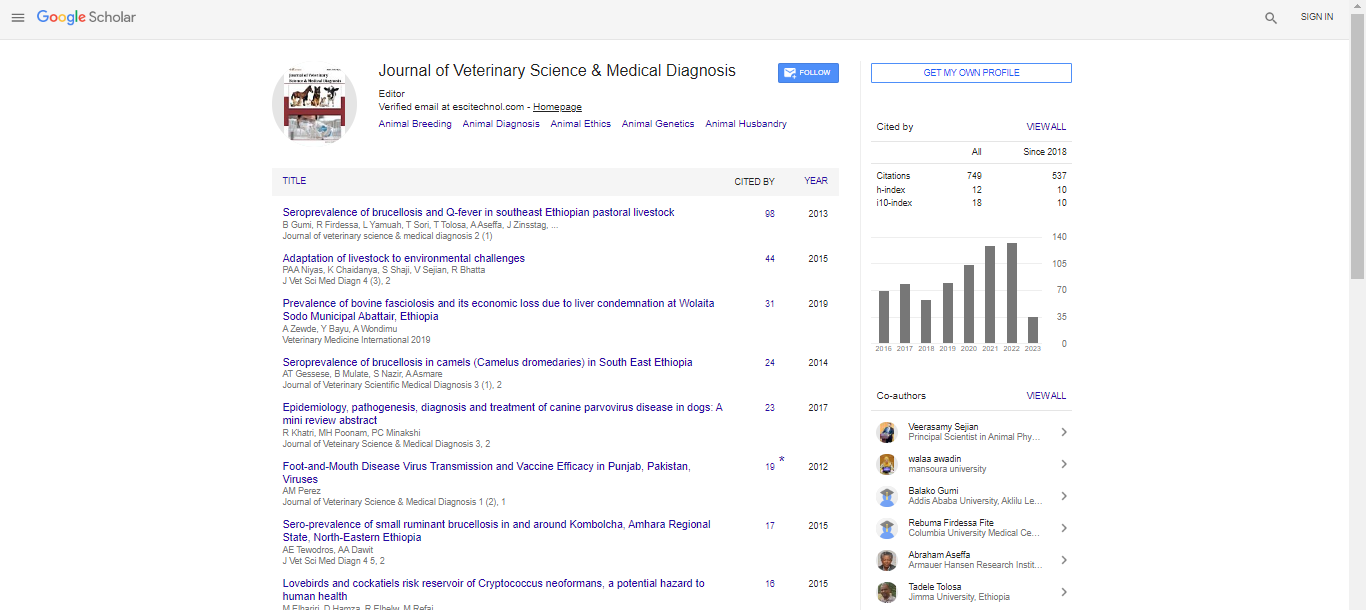Opinion Article, J Vet Sci Med Diagn Vol: 12 Issue: 2
Artificial Insemination and Embryo Transfer in Farm Animals
Deborah Burnett*
1Division of Veterinary Medicine, Garvan Institute of Medical Research, Darlinghurst, Australia
*Corresponding Author: Althea Wang
Division of Veterinary Medicine, Garvan
Institute of Medical Research, Darlinghurst, Australia
E-mail: d.burnett@mic.org.au
Received date: 22 February, 2023, Manuscript No. JVSMD-23-95350;
Editor assigned date: 27 February, 2023, Pre QC No. JVSMD-23-95350(PQ);
Reviewed date: 15 March, 2023, QC No. JVSMD-23-95350;
Revised date: 22 March, 2023, Manuscript No: JVSMD-23-95350(R);
Published date: 29 March, 2023, DOI: 10.35248/2325-9590.23.12.100049.
Citation: Burnett D (2023) Artificial Insemination and Embryo Transfer in Farm Anima. J Vet Sci Med Diagn 12:2.
Description
Artificial Insemination (AI) and Embryo Transfer (ET) are two reproductive technologies that have revolutionized the way breeding and genetic improvement of farm animals are carried out. These technologies have become important tools for livestock producers, allowing them to enhance the reproductive performance of their animals and achieve genetic progress at a faster rate.
Artificial insemination is the process of introducing sperm into the reproductive tract of a female animal without natural mating. AI technology has been used for many decades in various livestock species such as cattle, pigs, sheep, and goats. The process involves the collection of semen from a genetically superior male animal, processing and evaluating it, and finally, depositing it into the female reproductive tract. The main advantages of this technology is that it allows producers to use semen from high-value sires, increases genetic progress, and reduces the risk of transmitting sexually transmitted diseases. One of the most significant benefits of AI technology is its ability to increase the rate of genetic progress in livestock populations.
Producers can use semen from genetically superior males, which may not be physically present on their farm, to breed their female animals. This enables the farmer to access a wider range of genetic material than they would be able to if relying solely on natural breeding.
Additionally, this technology allows producers to have greater control over the timing and frequency of breeding, which can result in increased pregnancy rates and reduced calving intervals.
It also reduces the risk of transmitting sexually transmitted diseases between animals. When animals mate naturally, they can transmit diseases such as Bovine Viral Diarrhea (BVD), leptospirosis, and trichomoniasis. Despite the advantages of AI technology, there are also some limitations. One of the main challenges of AI technology is that it requires skilled personnel to perform the procedure correctly. Additionally, the success rate of AI can be influenced by various factors such as the timing of insemination, the quality of the semen, and the reproductive condition of the female animal.
Embryo transfer, on the other hand, involves removing embryos from a genetically superior female animal and transferring them to the reproductive tract of another female animal. The process is typically carried out on cattle and sheep, but it can also be used in pigs and horses. The embryos can be collected either non-surgically or surgically, depending on the species and the age of the donor female. The embryos are then evaluated and selected based on various criteria such as their quality, genetic merit, and developmental stage. Once the embryos are selected, they can be transferred to a recipient female for gestation and birth.
Embryo transfer technology has several advantages over traditional breeding methods. One of the most significant benefits of this method is that it allows for the production of multiple offspring from a single donor female. This can be especially useful for producers looking to rapidly expand their herd or improve their genetic pool. Additionally, this can help producers to overcome fertility problems in their female animals. This technology can bypass reproductive challenges such as low conception rates or infertility, allowing the farmer to maintain a high level of genetic progress. Despite its many advantages, this technology also has some limitations. One of the main challenges is it can be expensive, as it requires specialized equipment and skilled personnel. It can be time-consuming, as it involves multiple steps, including the selection and evaluation of embryos, synchronization of the donor and recipient animals, and embryo transfer itself.
 Spanish
Spanish  Chinese
Chinese  Russian
Russian  German
German  French
French  Japanese
Japanese  Portuguese
Portuguese  Hindi
Hindi 
